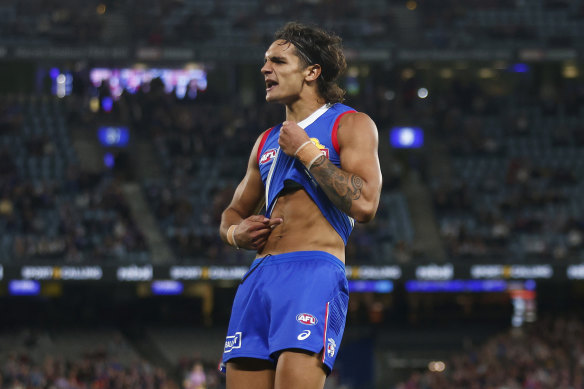
The AFL has long positioned itself at the forefront of progressive social causes, with Indigenous players in particular being held up as pillars of our beloved game. However, as we embark on another Dreamtime at the ’G, we face an uncomfortable truth: the number of Indigenous players is on the decline, and this trend threatens the very integrity of the game.
In 2020, the AFL had 87 Indigenous players; today, that number has shrunk to 71. Recruiters tell me that this number is likely to fall to the mid-60s next year due to retirements and a lack of talent coming through, and worsen from there.

Jamarra Ugle-Hagan recreated Nicky Winmar’s famous gesture by facing the crown and pointing to his skin in a game last year.Credit: Daniel Pockett - Getty Images
The downward trend is evident, and more troubling still is the stark lack of Indigenous representation in under-16 squads nationwide. Here the issues begin early and are deeply entrenched within the recruitment process. The number of Indigenous kids being drafted tells us that we’re far from where we need to be.
Drawing from my experience as a former high-performance rugby coach and researcher of Indigenous representation in elite sports, one clear pattern has emerged: recruiting Indigenous players is often perceived as more challenging than selecting their non-Indigenous peers.
The reluctance to draft Indigenous players can partly be traced back to persistent stereotypes. For example, young, standout Indigenous talent who come from tough backgrounds are often unfairly labelled as “difficult” or “non-committal” when logistical hurdles, such as lack of transport, cause them to miss training sessions.
More unsettling still, the recruitment process can ignore cultural nuance. A quiet Indigenous teen might be viewed as a non-contributor because shyness is misunderstood as a lack of commitment or leadership capability. The recruitment criteria isn’t an exact science and certainly doesn’t take into account cultural differences in demeanour and expression, in a setting where bravado can be seen as dedication.
This bias also extends into the metrics we use to judge potential players. The AFL’s overreliance on fitness and aptitude tests, which prioritise physical benchmarks over football skills, often fails to capture these young athletes’ true capabilities and potential. That’s true for anyone who comes to the game differently. Beep tests, sprint tests and vertical jump tests are central to the drafting process, though many football greats of the past would not meet the standards of today.
Meanwhile, anointing players at the age of 15 or 16 disregards a vast pool of potential talent. Players not in the elite pathway system by this age are often considered lost to the game. Similarly, players from outside the private school circuits – specifically the Associated Grammar Schools of Victoria and Associated Public Schools pipelines that feed into the AFL – are overlooked as well.



























